36 Common Backyard Birds in Connecticut
Last Updated on
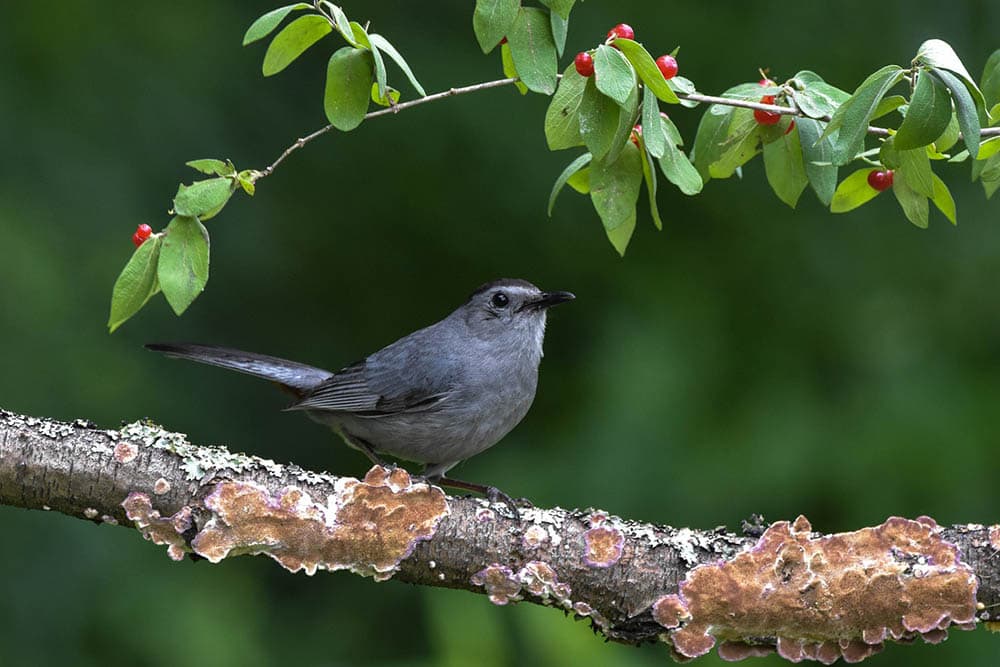
There are nearly 300 species of birds in Connecticut, including migratory birds, birds of prey, and water birds. There are also those that live among people, visiting the backyards of homes and thrilling homeowners with their alluring songs and striking colors. Whether you’ve spotted a bird you’re trying to identify or are generally interested in the feathered visitors to your home, below is a list of 36 common backyard birds in Connecticut. 
Year-Round
1. American Crow

| Size: | 20 inches |
| Weight: | 20 ounces |
| Colors: | Black |
The American Crow is an all-black carrion bird. It is found in most states and will feed on most insects on the ground, as well as fish and mussels in the water. It is possible to easily attract crows, but they can gather in large numbers and will eat pet food and garbage, so do so cautiously.
2. American Goldfinch
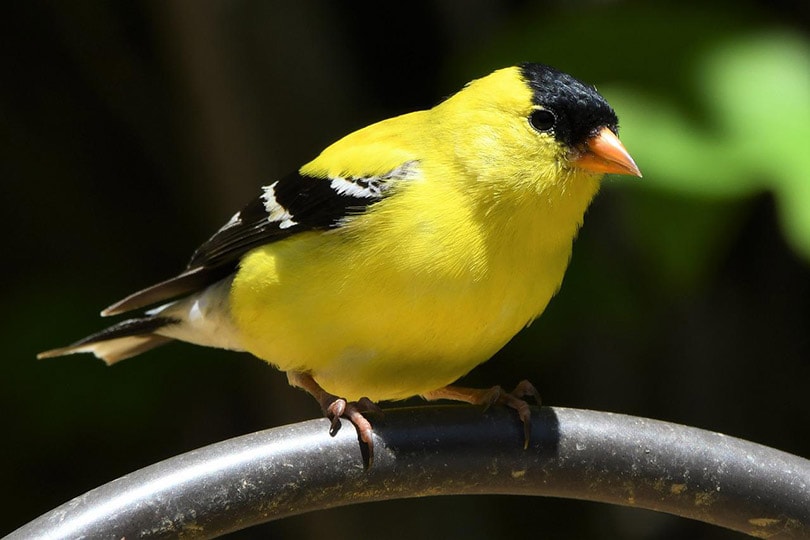
| Size: | 5 inches |
| Weight: | 0.5 ounces |
| Colors: | Yellow, Black, White |
The American Goldfinch is another species that is found throughout most of the country and resides in Connecticut all year. They primarily eat plants, including sunflower and thistle, and planting these can help attract them to your yard.
3. Black-Capped Chickadee

| Size: | 5 inches |
| Weight: | 0.5 ounces |
| Colors: | Black, White, Gray |
Black-Capped chickadees are found in the northern half of America and will stay in Connecticut throughout the year. They are inquisitive birds that will approach you in some cases. They feed on seeds and berries and will also eat insects. To attract them to your garden, you can offer them sunflower seeds and suet. They will even enjoy peanut butter from time to time.
4. Blue Jay
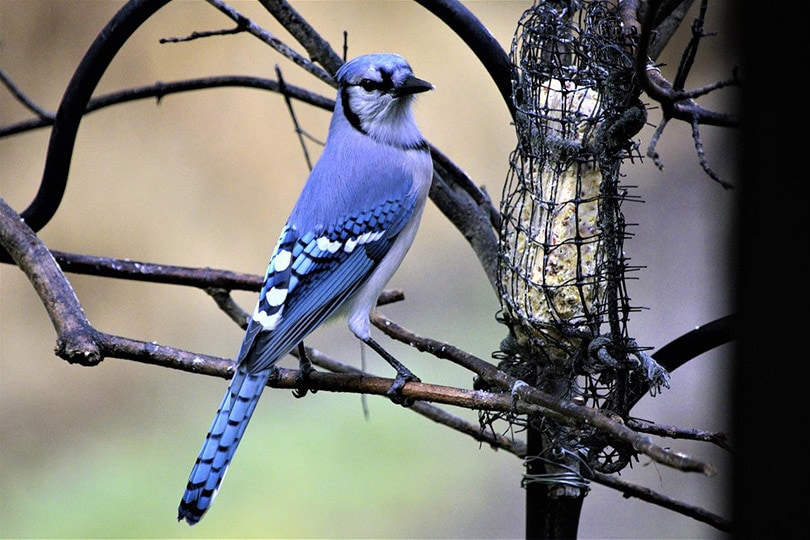
| Size: | 11 inches |
| Weight: | 3 ounces |
| Colors: | Blue, Black, White |
The Blue Jay is a distinctive looking bird that is predominantly blue in color, although it does have a white belly and black markings on its back. The Blue Jay is one of the most common of Connecticut songbirds and they can be quite noisy. They eat acorns as well as insects, nuts, and even eggs. Peanuts and sunflower seeds are their preferred food at the feeder but expect them to fly away to consume them.
5. Carolina Wren

| Size: | 5 inches |
| Weight: | 0.8 ounces |
| Colors: | Brown, White |
Carolina Wrens are shy and one of a number of brown birds in Connecticut that stay throughout the year and do not migrate. They tend to live in areas with plenty of vegetation but can be attracted to feeders with sunflower seeds and suet feeders.
6. Downy Woodpecker

| Size: | 6 inches |
| Weight: | 1 ounce |
| Colors: | Black, White, Red |
The Downy Woodpecker is a relatively small bird that is a common sight at backyard feeders. They look similar to but are smaller than the Hairy Woodpecker. Although they tend to prefer insects, they can be attracted to a feeder with suet or with sunflower seeds and peanuts.
7. Eastern Bluebird
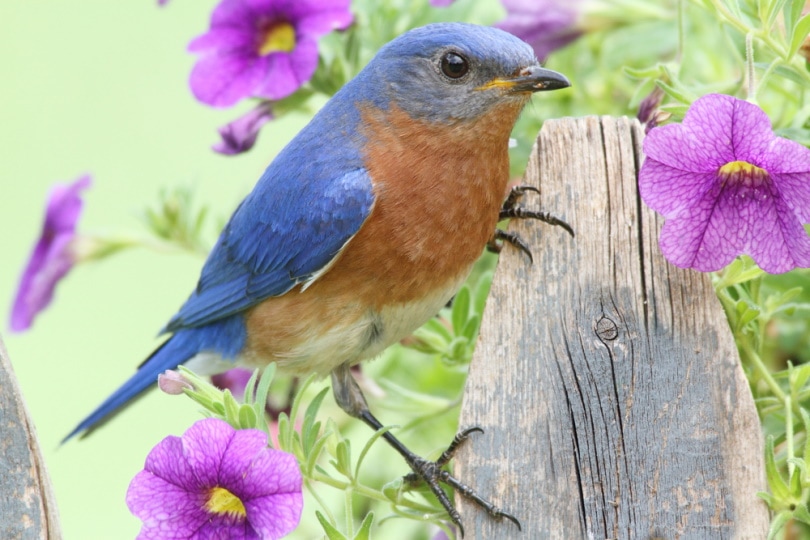
| Size: | 8 inches |
| Weight: | 1 ounce |
| Colors: | Blue, Brown, White |
The Eastern Bluebird is a small bird with a blue back and a red-colored belly. They live in the US all year round and tend to reside in meadows and fields. They can be attracted with mealworms but will only usually venture into open yards that aren’t too closed in.
8. European Starling
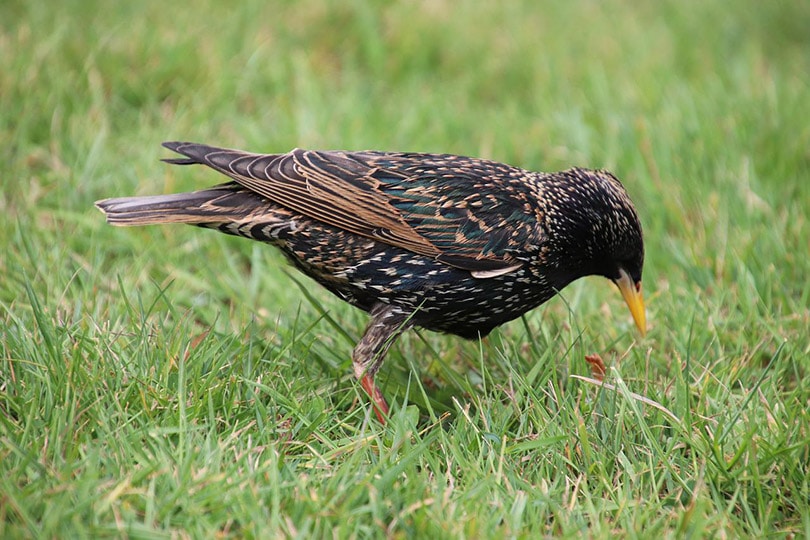
| Size: | 9 inches |
| Weight: | 3 ounces |
| Colors: | Black, Purple, Green, Blue |
Although one of the most common Connecticut songbirds, the European Starling, as the name suggests, is not native to Connecticut and was introduced in the state. They are considered a pest by some, but you can attract them to your property with sunflower seeds and suet.
9. Hairy Woodpecker

| Size: | 10 inches |
| Weight: | 3 ounces |
| Colors: | Black, White, Red |
The Hairy Woodpecker is considered a medium-sized woodpecker and is found year-round in the state. It is larger than the Downy Woodpecker but shares similar markings. They live in large trees and can be attracted to your yard with a suet feeder.
10. House Finch
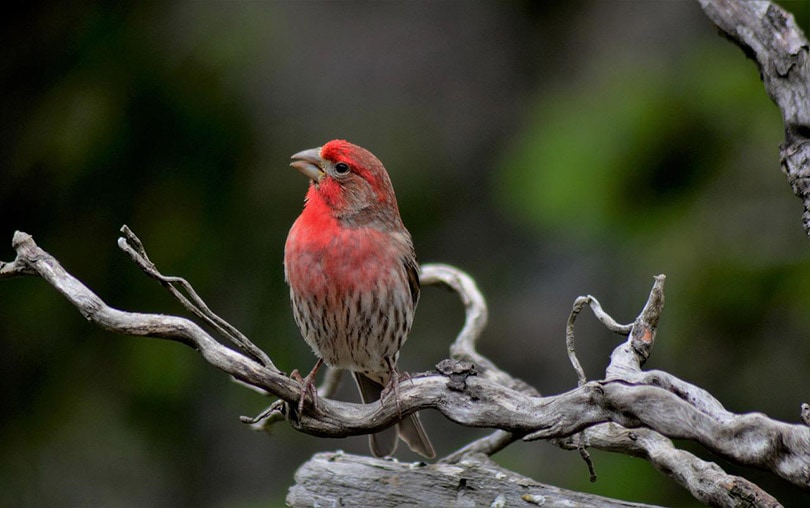
| Size: | 5 inches |
| Weight: | 0.8 ounces |
| Colors: | Brown, Red |
The House Finch is a year-round resident of Connecticut and does not migrate. As well as being found in yards, they are often spotted in parks and farms and can be noisy, especially when in large groups. Attract them using black oil sunflower seeds.
11. House Sparrow

| Size: | 6 inches |
| Weight: | 1 ounce |
| Colors: | Gray, Brown, White |
The House Sparrow is not a true native, but this introduced species can be spotted in Connecticut all year round. The species can be encouraged to eat from your hand, and millet is a good choice to attract them to your yard.
12. Mourning Dove
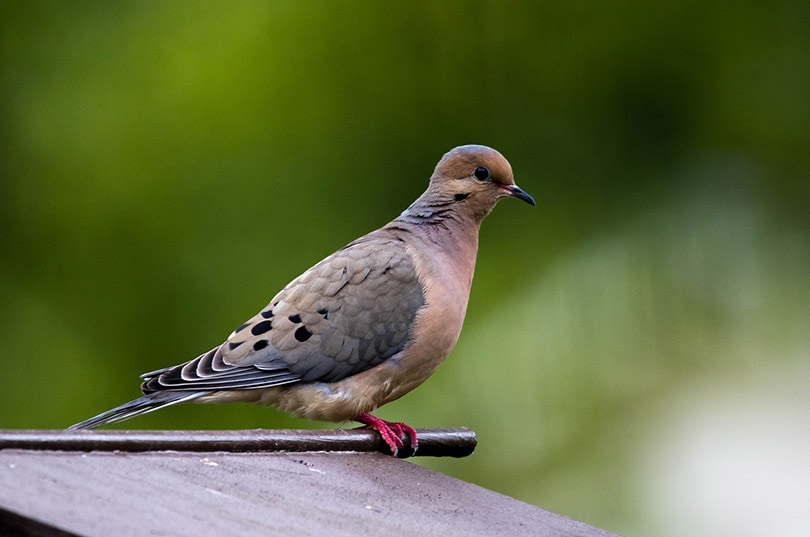
| Size: | 12 inches |
| Weight: | 5 ounce |
| Colors: | Brown, Black |
The Mourning Dove is one of the most commonly seen summer birds in Connecticut but can be spotted year-round. They forage for seeds and can be found in fields and parks as well as yards. Sprinkle food on the ground to attract them. Sunflower seeds and corn tend to be popular.
13. Northern Cardinal
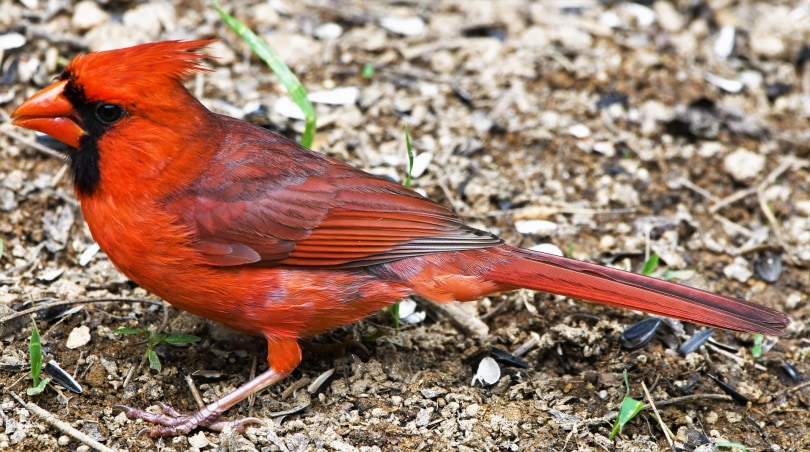
| Size: | 9 inches |
| Weight: | 1.5 ounces |
| Colors: | Brown, Red |
Northern Cardinals are one of the most commonly seen backyard birds and red birds in Connecticut. They live on seeds and will eat fruit and some insects. They can be aggressive during the breeding season, but you can attract them with sunflower seeds and peanuts.
14. Northern Flicker

| Size: | 12 inches |
| Weight: | 5 ounces |
| Colors: | Black, White, Red, Yellow |
The Northern Flicker is a large woodpecker that resides in Connecticut all year. They eat fruit and seeds as well as insects and beetles. If you want to encourage these woodpeckers to your yard, put out suet feeders.
15. Northern Mockingbird

| Size: | 10 inches |
| Weight: | 2 ounces |
| Colors: | Brown, White |
The Northern Mockingbird is another bird that can be spotted in Connecticut yards all year round, although more often during the warmer months. The mockingbird is known for mimicking the songs of other birds and can learn as many as 200 in their life. Plant fruit bushes to attract these birds to your yard because they will rarely visit feeders.
16. Red-Bellied Woodpecker
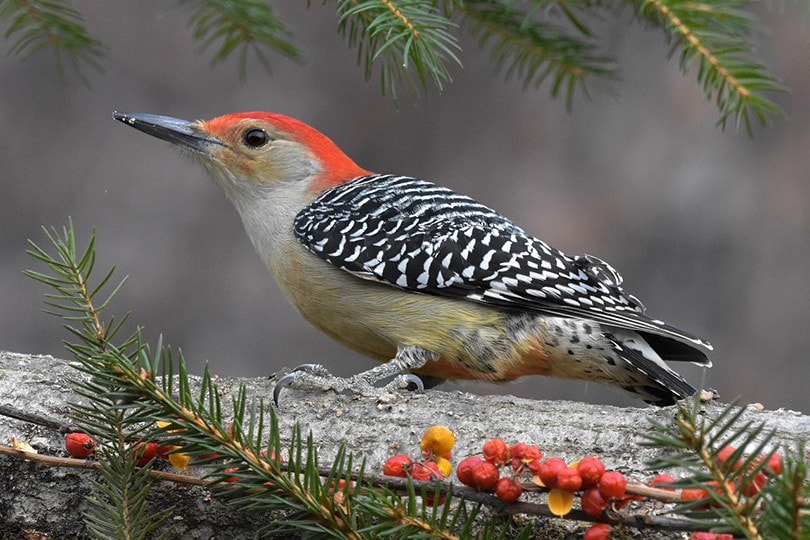
| Size: | 9 inches |
| Weight: | 3 ounces |
| Colors: | Brown, Red, White |
The Red-Bellied Woodpecker is a small woodpecker that doesn’t migrate and can be spotted in Connecticut throughout the year. They nest in trees and eat seeds as well as insects and spiders. They can be attracted with sunflower seeds.
17. Song Sparrow
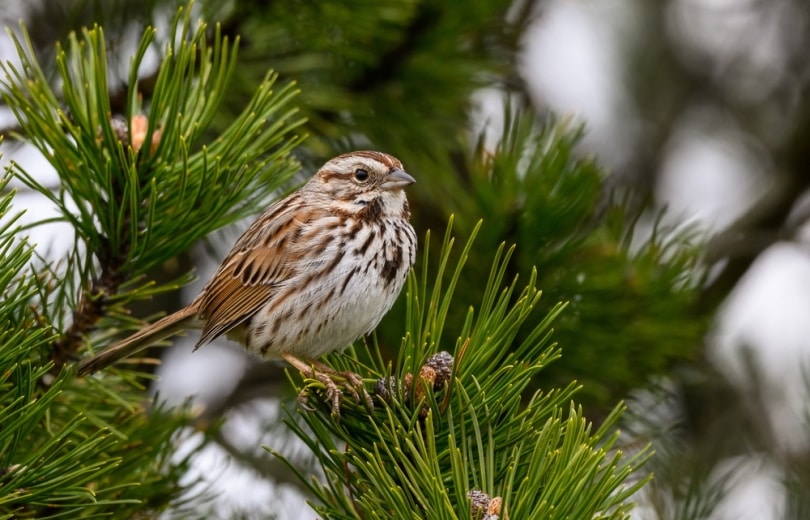
| Size: | 6 inches |
| Weight: | 1.5 ounces |
| Colors: | Brown, White |
The Song Sparrow is a brown bird that has an attractive song. It is a common sight in Connecticut gardens, especially during the warmer months, and eats a variety of insects and seeds. They will also eat most treats put out at feeders and are generally considered easy to attract to a yard.
18. Tufted Titmouse

| Size: | 6 inches |
| Weight: | 0.8 ounces |
| Colors: | Gray, White |
The Tufted Titmouse is commonly seen throughout the year and does not migrate. They are seen in parks as well as backyards and can be attracted by sunflower seeds and suet cages.
19. White-Breasted Nuthatch

| Size: | 5.5 inches |
| Weight: | 1 ounce |
| Colors: | Gray, Black, White, Brown |
The White-Breasted Nuthatch is seen throughout the year and is one of the more common birds at winter feeders. It lives in forests and woodlands and feeds on insects and their larvae. Sunflower seeds and peanuts will help attract this bird to your backyard feeder.

Summer
20. Tree Swallow

| Size: | 6 inches |
| Weight: | 0.8 ounces |
| Colors: | Blue, Green, Gray, White |
The Tree Swallow has a dark blue or green-tinted back. It prefers open space to backyards, but you may be able to attract them with sunflower seeds and some slices or pieces of apple. In late August, millions of the species can be seen migrating from the area in an “avian ballet” during the evenings.
21. American Robin
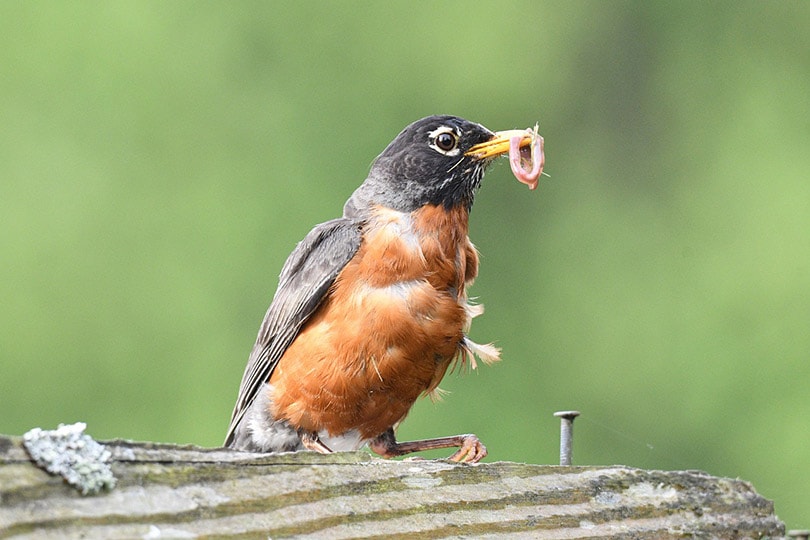
| Size: | 10 inches |
| Weight: | 3 ounces |
| Colors: | Black, Brown |
American Robins are a very common summer bird in Connecticut gardens and may be seen occasionally in winter months. They do still reside in the state in winter, but roost in trees. They are more likely to be spotted rooting out worms from yards in summer. Sunflower seeds scattered on the ground or suet placed on the ground are the most likely to attract this bird.
22. Barn Swallow

| Size: | 7 inches |
| Weight: | 0.7 ounces |
| Colors: | Black, Brown |
Barn Swallows are seen in the summer months during the breeding season but migrate to Central and South America during winter. They eat insects and build nests in farmland. It can be difficult to attract this bird to a feeder, but they can be tempted with broken eggshells or oyster shells.
23. Brown-Headed Cowbird
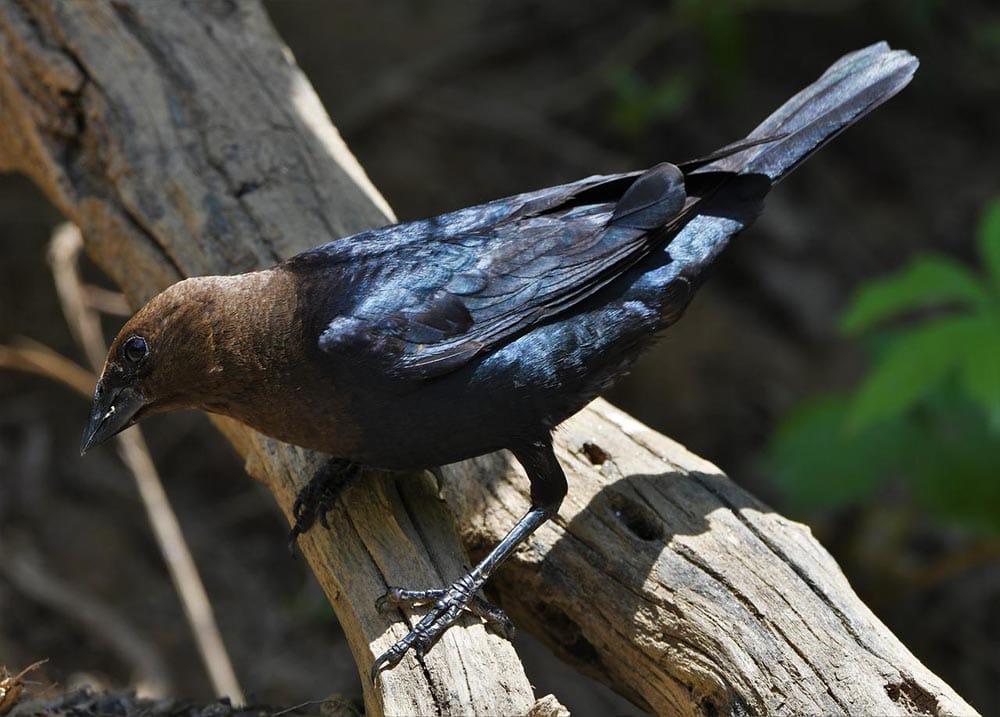
| Size: | 8 inches |
| Weight: | 1.8 ounces |
| Colors: | Black, Brown |
The Brown-Headed Cowbird resides in Connecticut during the summer months. As a species, they migrate south for winter, but a small number remain so they can rarely be seen in winter. Few people try to attract this species because they kill songbird eggs.
24. Cedar Waxwing

| Size: | 6 inches |
| Weight: | 1 ounce |
| Colors: | Brown, Gray, Yellow |
Cedar Waxwings do remain in Connecticut through the year but are rarely spotted in winter. In summer, they can be seen in woodlands and near water. Although they will rarely eat from feeders, they can be encouraged to your yard with shrubs that yield small fruit.
25. Chipping Sparrow
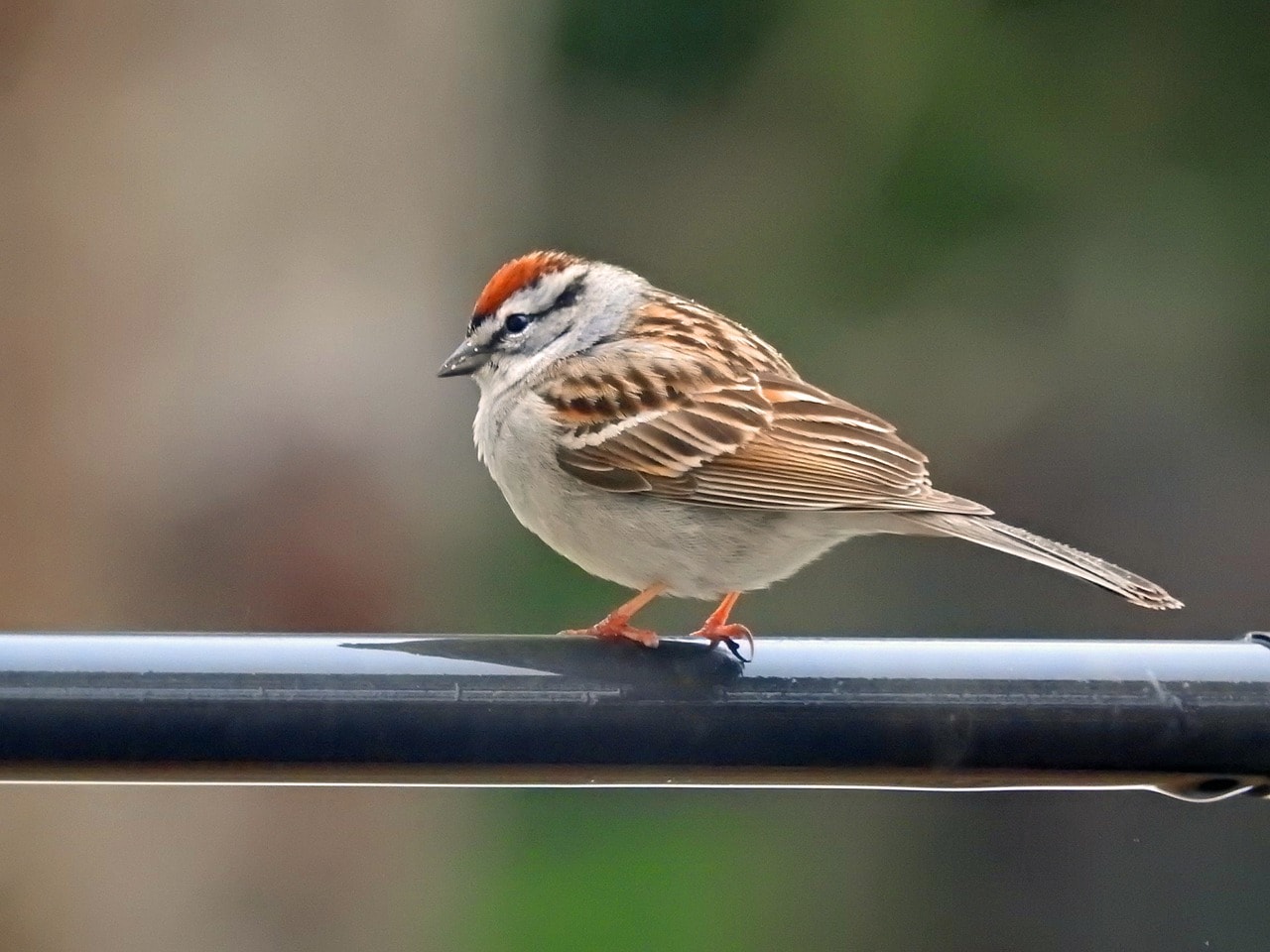
| Size: | 6 inches |
| Weight: | 0.5 ounces |
| Colors: | Gray, Brown, Black |
Chipping Sparrows are quite common during the summer months but migrate to Florida during the winter months and are rarely seen at this time of year. They tend to travel and feed in small flocks. To attract the Chipping Sparrow, put out seeds on open feeders.
26. Common Grackle
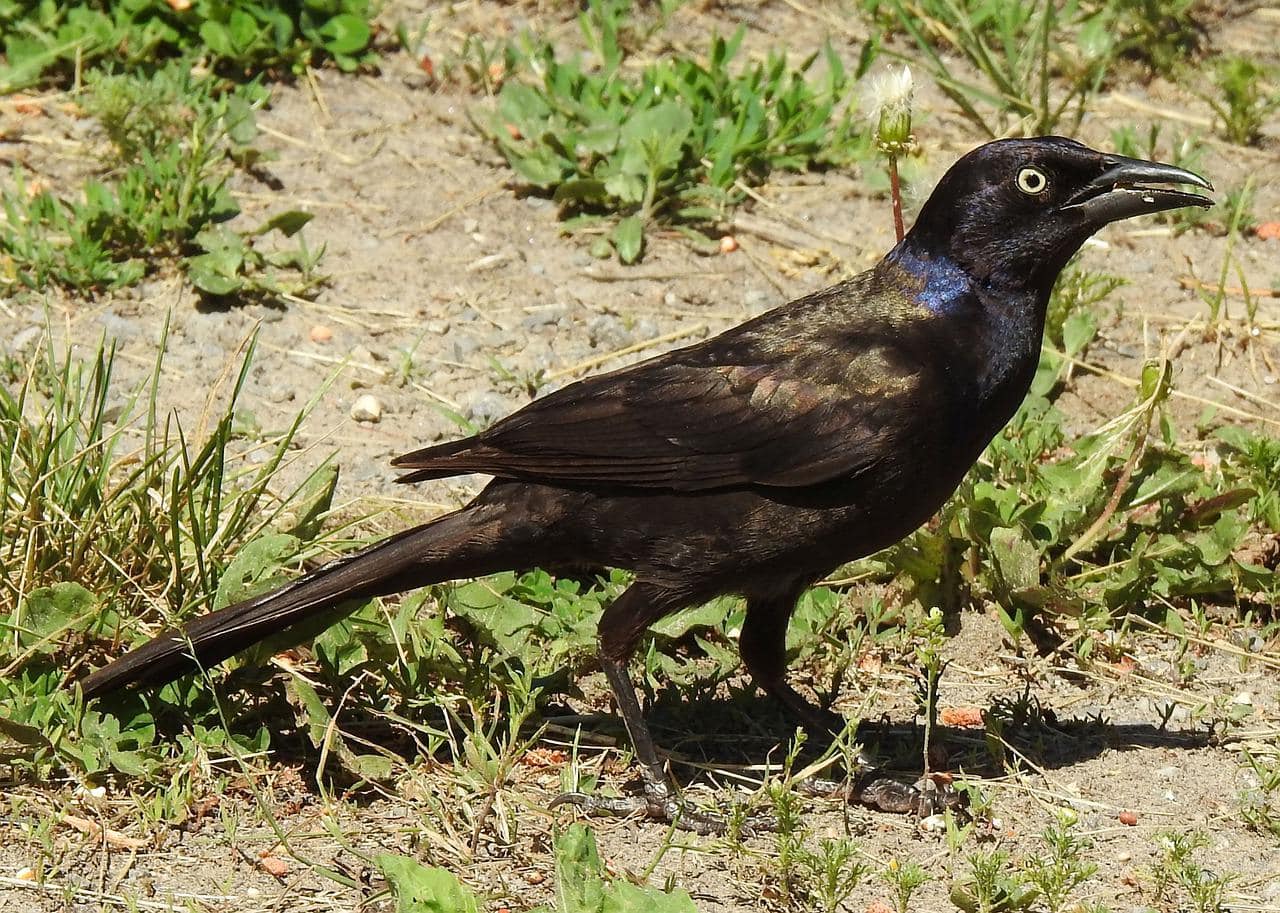
| Size: | 13 inches |
| Weight: | 5 ounces |
| Colors: | Black, Blue |
The Common Grackle is a large blackbird. Although their numbers are dwindling, they do gather in large flocks. They are considered a pest because they eat garbage and make a lot of noise, but they can be attracted by seeds spread on the ground.
27. Common Yellowthroat
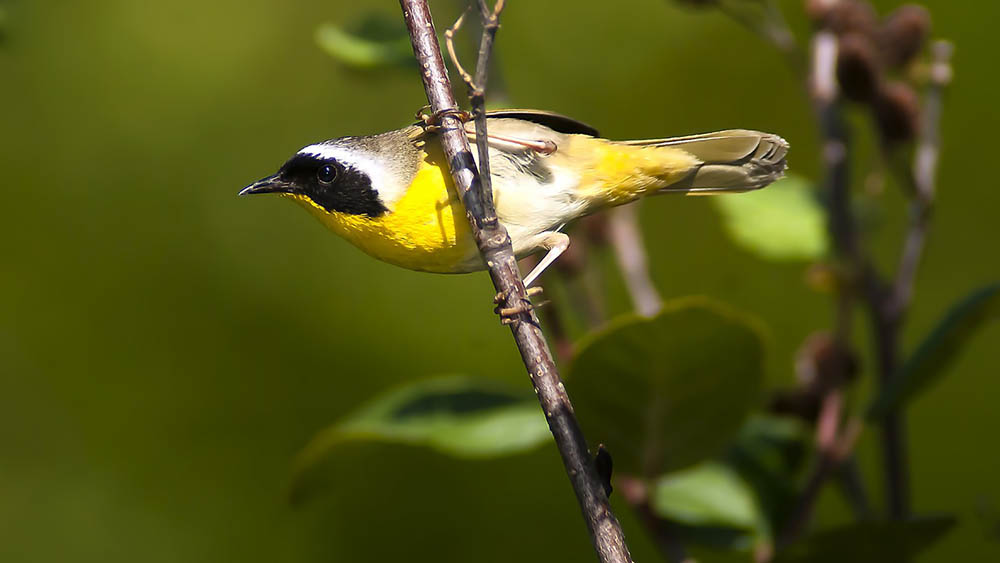
| Size: | 5 inches |
| Weight: | 0.3 ounces |
| Colors: | Brown, Yellow, Black, White |
The Common Yellowthroat migrates south for winter but can be spotted quite easily in Connecticut during the summer months. They prefer wetland areas and will be attracted to yards that have plenty of vegetation where they can feed on insects.
28. Gray Catbird

| Size: | 9 inches |
| Weight: | 2 ounces |
| Colors: | Gray, Black, Red |
The Gray Catbird breeds in the US before heading to the Caribbean for the winter months. It is named for its song that sounds like a cat meowing and that can last for several minutes. Fruit trees offer the most likely method to attract this pretty bird to your garden.
29. House Wren

| Size: | 5 inches |
| Weight: | 0.4 ounces |
| Colors: | Brown, White |
The House Wren is a small brown bird that is seen in the summer months but mostly migrates for winter. Some may remain during winter. They are often seen in backyards where they forage for seeds and eat insects. Putting up nesting boxes can help encourage the House Wren to your yard.
30. Red-Eyed Vireo

| Size: | 5 inches |
| Weight: | 0.8 ounces |
| Colors: | Brown, White |
When adults, the Red-Eyed Vireo have red eyes, but the young have black eyes that change color as they age. Typically found in and around maple trees, this bird can be coaxed to your yard with orange slices, which they are particularly keen on.
31. Red-Winged Blackbird
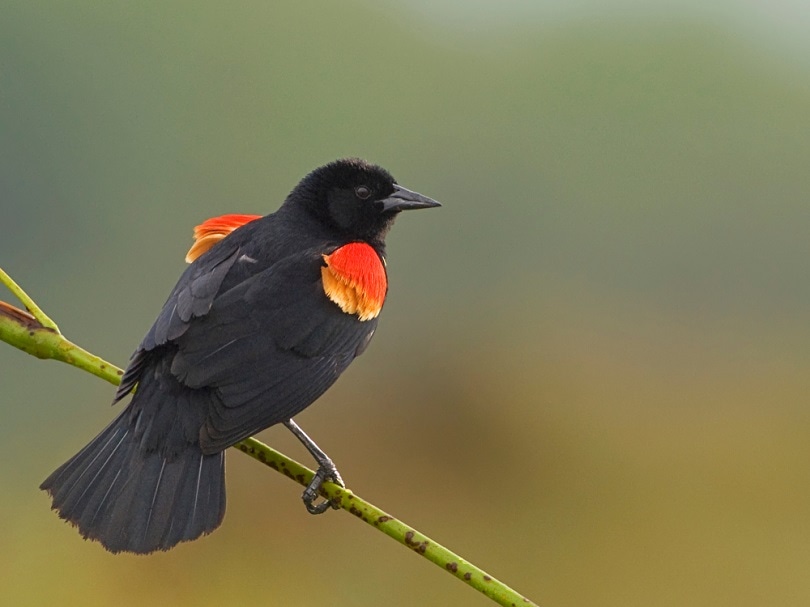
| Size: | 9 inches |
| Weight: | 2.5 ounces |
| Colors: | Black, Red, Brown |
The Red-Winged Blackbird is a black bird that is most often seen in the summer months, although a few do remain during winter. The males are easy to spot because of the red band on their wings, but like most blackbird breeds, the females are somewhat plain with streaky brown markings. They prefer to be fed on the ground and will be attracted by mixed seeds.
32. Yellow Warbler
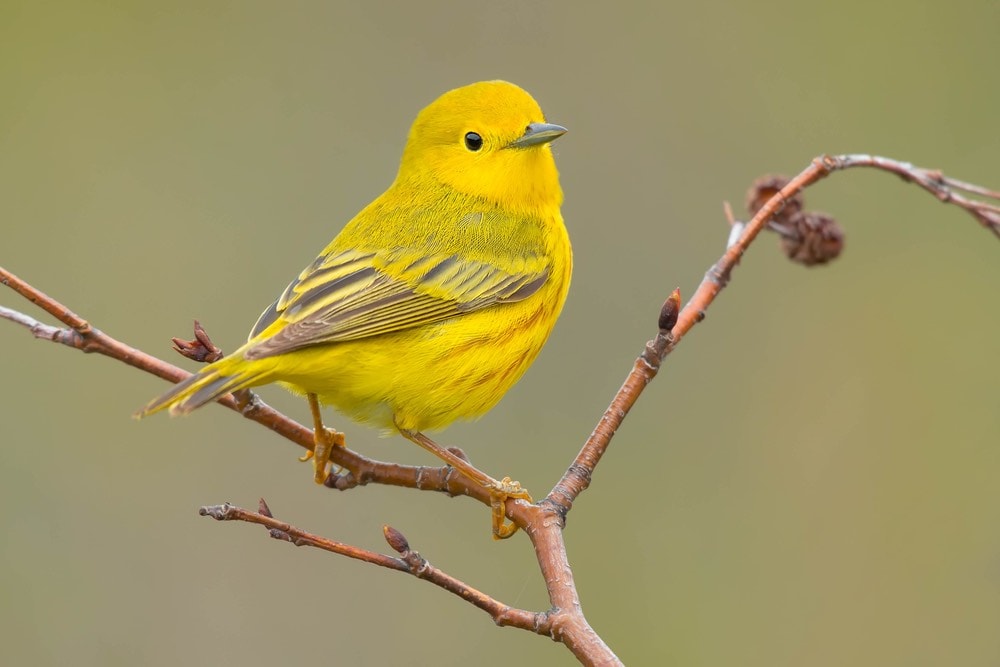
| Size: | 5 inches |
| Weight: | 0.4 ounces |
| Colors: | Yellow, Green, Chestnut |
The Yellow Warbler migrates in October but is a fairly common sight during the summer months in Connecticut. They tend to live near water and feed on the edges of fields and can be attracted with orange slices or suet feeders. You can also provide water for them to bathe in.
33. Yellow-Rumped Warbler

| Size: | 5 inches |
| Weight: | 0.5 ounces |
| Colors: | Gray, Yellow, White |
The Yellow-Rumped Warbler is another species most often seen between April and October. They are found in forests and like fruit shrubs. Therefore, try feeding raisins as well as sunflower seeds to encourage them closer to your yard.

Winter
34. Dark-Eyed Junco
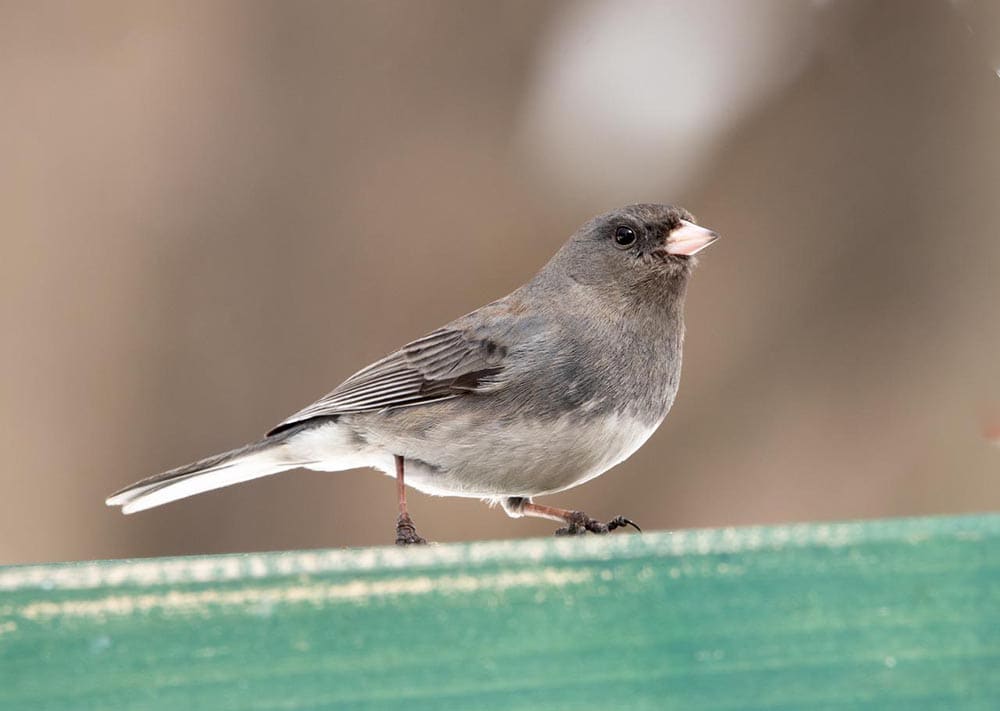
| Size: | 6 inches |
| Weight: | 1 ounce |
| Colors: | Gray |
The Dark-Eyed Junco is a gray bird that lives in Connecticut in the winter months, although a small number do remain during summer, so it may be possible to spot them at this time of year as well. They like seeds and you can use a platform feeder to encourage them to gather in your yard.
35. Pine Siskin

| Size: | 5 inches |
| Weight: | 0.5 ounces |
| Colors: | Brown, Yellow, White |
The Pine Siskin is a small bird that likes to live in the woods and is most commonly seen during the winter months. They do visit yards, and they are especially attracted to millet and thistle.
36. White-Throated Sparrow
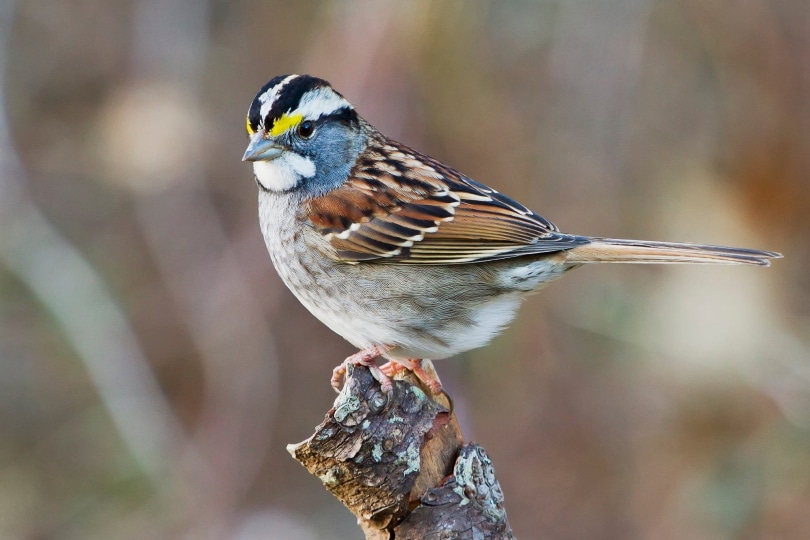
| Size: | 7 inches |
| Weight: | 1 ounce |
| Colors: | Black, White, Yellow, Brown |
The White-Throated Sparrow is found in Connecticut during the winter months and is most often seen in wooded areas. It eats grasses and seeds, as well as fruit, but will also eat insects. Millet and black oil sunflower seeds will attract them if placed on a platform feeder.

Conclusion
There are hundreds of species of bird in Connecticut, including native species as well as those that have been introduced and have taken hold. Above is a list of 36 of the most commonly found backyard species in Connecticut, including a good variety of woodpeckers, songbirds, and more.
Featured Image Credit: JackBulmer, Pixabay
Table of Contents
- Year-Round
- 1. American Crow
- 2. American Goldfinch
- 3. Black-Capped Chickadee
- 4. Blue Jay
- 5. Carolina Wren
- 6. Downy Woodpecker
- 7. Eastern Bluebird
- 8. European Starling
- 9. Hairy Woodpecker
- 10. House Finch
- 11. House Sparrow
- 12. Mourning Dove
- 13. Northern Cardinal
- 14. Northern Flicker
- 15. Northern Mockingbird
- 16. Red-Bellied Woodpecker
- 17. Song Sparrow
- 18. Tufted Titmouse
- 19. White-Breasted Nuthatch
- Summer
- Winter
- Conclusion
About the Author Robert Sparks
Robert’s obsession with all things optical started early in life, when his optician father would bring home prototypes for Robert to play with. Nowadays, Robert is dedicated to helping others find the right optics for their needs. His hobbies include astronomy, astrophysics, and model building. Originally from Newark, NJ, he resides in Santa Fe, New Mexico, where the nighttime skies are filled with glittering stars.
Related Articles:
10 Types of Hummingbirds in Arkansas (With Pictures)
8 Types of Hummingbirds in Nebraska (With Pictures)
5 Types of Hummingbirds in Idaho (With Pictures)
3 Types of Hummingbirds in Mississippi (With Pictures)
8 Types of Hummingbirds in Kansas (With Pictures)
5 Types of Hummingbirds in West Virginia (With Pictures)
5 Types of Hummingbirds in Ohio (With Pictures)
Where Do Nuthatches Nest? Nuthatch Nesting Habits Explained
